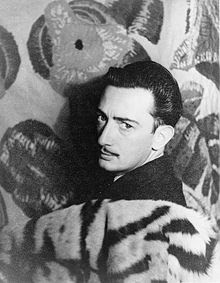 In the rather peaceful years following WW1, other movements that will replace Dada, with Surrealism being the first and most descendant. Andre Breton was the instigator of Surrealism in 1924. A writer, not an artist, Breton followed the Dada philosophy of allowing things to happen naturally in his work rather than putting words together in a logical way. His emphasis on a dream world, word association games and unconscious writing was carried into the visual world of Surrealist painters and sculptors. Salvador Dali put his fantastic ideas and dreams on canvas in the Surrealist movement.
In the rather peaceful years following WW1, other movements that will replace Dada, with Surrealism being the first and most descendant. Andre Breton was the instigator of Surrealism in 1924. A writer, not an artist, Breton followed the Dada philosophy of allowing things to happen naturally in his work rather than putting words together in a logical way. His emphasis on a dream world, word association games and unconscious writing was carried into the visual world of Surrealist painters and sculptors. Salvador Dali put his fantastic ideas and dreams on canvas in the Surrealist movement.Salvador Domingo Felipe Jacinto Dalí i Domènech (May 11, 1904 – January 23, 1989), commonly known as Salvador Dalí, was a prominent surrealist painter born in Figueres.
Dalí was a skilled draftsman, best known for the striking and bizarre images in his surrealist work. His painterly skills are often attributed to the influence of Renaissance masters. His best-known work, The Persistence of Memory, was completed in 1931. Dalí's expansive artistic repertoire includes film, sculpture, and photography, in collaboration with a range of artists in a variety of media.
His life itself was so thoroughly surrealistic-his wild actions, his weird utterances, his flamboyant clothing-that his integrity as an artist has often been questioned. Dalí attributed his "love of everything that is gilded and excessive, my passion for luxury and my love of oriental clothes" to a self-styled "Arab lineage," claiming that his ancestors were descended from the Moors.
Dalí was highly imaginative, and also had an affinity for partaking in unusual and grandiose behavior, in order to draw attention to himself. His personal painting style, influenced at first by Picasso and Miro, soon developed into a magical presentation of incredible draughtsmanship and three-dimensional space. Dali uses exacting realism in every part of his paintings because he claimed to "hate simplicity in all its forms," thus rejecting abstraction of any other simplified form of art.
Later in his life, Dali began painting religious subject with his unique style and symbolism. His detail and painting techniques are wonders to craftsmanship. The composition is designed and carried out meticulously. The image, as in all Surrealist and Fantasy art, leaves the viewer with more questions than answers.
Dali transformed the definition of Surrealism, expressing the unconscious process of thought, dream and associated realities through his paintings and drawings. An eccentric and masterful Surrealist in painting and in life, Dali wrote in his diary two years before entering art school in Madrid during the early 1920s: "Perhaps I’ll be despised and misunderstood, . . . but I’ll be a great genius."
Dalí subsequently embraced the psychoanalytic theories of Sigmund Freud, assimilating them into his paintings. The artist's invention of the Paranoiac-Critical method allowed Dalí to explore the deepest recesses of the subconscious while producing many of his complex career's most recognizable works.
Throughout his life, Dali cultivated eccentricity and a predisposition towards narcissistic exhibitionism, claiming that his creative energies were derived from it. The spectrum of imagery from fantastic to nightmarish visions which Dali produced are the supreme evidence of these idiosyncrasies.
Works
The Persistence of Memory (1931)
Face of Mae West Which May Be Used as an Apartment, (1935)
Soft Construction with Boiled Beans (Premonition of Civil War) (1936)
Swans Reflecting Elephants (1937)
Ballerina in a Death's Head (1939)
The Temptation of St. Anthony (1946)
Galatea of the Spheres (1952)
Crucifixion (Corpus Hypercubus) (1954)
Apparition of Face and Fruit Dish on a Beach
 Artist Salvador Dalí
Artist Salvador DalíYear 1938
Type Oil on canvas
Dimensions 114.8 cm × 143.8 cm (45.2 in × 56.6 in)
Location Wadsworth Atheneum, Hartford, Connecticut
This is one of my favorite painting of all time! I came across this painting in my Art History class back in 2000. I get to have a more detail look at it again later from the art history book which I loan from the library. After moments of staring at it, I was really shocked when I saw two subjects in 1 painting which was painted in 2 different dimension/perspective. Dali really inspired me after that.
I was running around crazily to my room mates after that, showing them and testing them if they can see what I have just saw. ( can you see?? YES YOU!!!)
(There are four scenes in one : you can see an Afghan dog, a face, a table with a fruit dish in the middle and a desert landscape looking out on the sea. The bridge in the landscape is the dog's collar, the figure in the desert is nose and mouth of the face.)
This oil on canvas masterpiece exemplifies the artist's refinement of his Paranoiac-Critical method. The painting combines multiple embedded images of a dog, human face and a fruit dish with pears on a tabletop against a beach landscape. One image's contours meld seamlessly into those of another, creating a heightened sense of visual drama meant to disturb the viewer.
One of my favourite surrealist painter.
ReplyDeleteThanks for sharing :) i have the opportunity to learn about one more artist
ReplyDelete